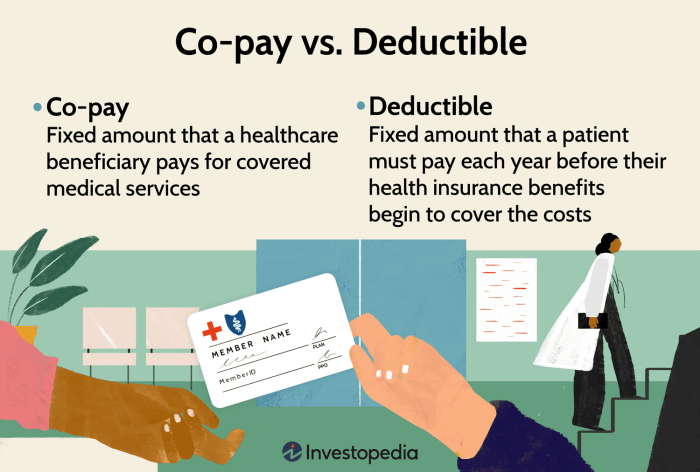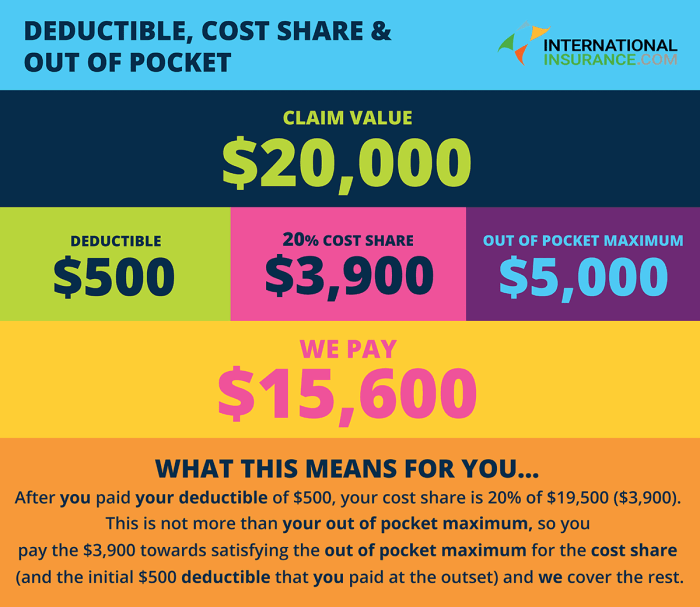Navigating the complexities of tax deductions can feel like deciphering a secret code, especially when it comes to personal life insurance premiums. While the idea of reducing your tax burden is appealing, understanding which life insurance premiums are deductible and which aren’t requires a clear understanding of IRS regulations and your specific policy. This guide unravels the intricacies of life insurance premium deductibility, offering insights into the factors that influence this crucial aspect of financial planning.
We’ll explore the different types of life insurance policies, examining how their structures impact their deductibility. We’ll delve into both federal and state tax implications, highlighting key differences and potential pitfalls. Through illustrative examples and clear explanations, we aim to empower you with the knowledge to confidently assess the deductibility of your life insurance premiums.
Introduction to Personal Life Insurance Premiums and Deductibility

Personal life insurance premiums represent the regular payments made to an insurance company in exchange for a death benefit. This benefit, payable to a designated beneficiary upon the insured’s death, provides financial security for surviving loved ones. The amount of the premium depends on several factors, including the policy type, the insured’s age and health, the death benefit amount, and the policy’s term. Understanding these premiums and their potential tax implications is crucial for financial planning.
Life insurance premiums are generally not deductible for federal income tax purposes. This is a key difference between personal life insurance and some business-related life insurance policies. However, there are limited exceptions and situations where certain aspects of premiums might be considered, although this is rare for individual policies.
Types of Life Insurance Policies and Premium Structures
Several types of life insurance policies exist, each with its own premium structure. Term life insurance provides coverage for a specific period (the term), with premiums generally remaining level during that time. Whole life insurance, on the other hand, offers lifelong coverage and often includes a cash value component that grows over time. Premiums for whole life insurance are typically higher than for term life insurance of equivalent coverage, reflecting the permanent nature of the policy and the cash value accumulation. Universal life insurance offers more flexibility in premium payments and death benefit amounts, allowing policyholders to adjust their coverage as needed. The premium structure for universal life policies can vary significantly depending on the policy’s features and the policyholder’s choices. Variable life insurance also offers a cash value component, but the investment performance of this component is subject to market fluctuations. Premiums for variable life insurance are typically similar to whole life, although the potential for growth (and loss) in the cash value component is a significant factor.
Situations Where Life Insurance Premiums Might Be Considered for Tax Deductions
While generally not deductible, there are very specific and limited circumstances where some aspects of life insurance premiums might have tax implications. For instance, in certain business contexts, premiums paid on a life insurance policy owned by a business on a key employee might be partially deductible as a business expense. This is often a complex situation and depends on specific details of the business structure and the policy’s design. Another situation is the potential deduction of premiums paid for a policy used to fund a buy-sell agreement. In this case, the premiums may be deductible as a business expense if they meet specific criteria, and it’s crucial to consult with a tax professional. It is important to note that even in these scenarios, deductibility is subject to various rules and regulations, and not all premiums will qualify for a deduction. These situations are highly specific and require careful consideration of the tax laws and professional tax advice.
Federal Tax Deductibility Rules for Life Insurance Premiums
Generally, life insurance premiums are not deductible for federal income tax purposes. This is a significant difference compared to some other types of insurance, and understanding the exceptions is crucial for accurate tax filing. The IRS has specific rules governing situations where deductions might be allowed, but these are quite limited.
The Internal Revenue Service (IRS) regulations regarding the deductibility of life insurance premiums are primarily focused on situations where the life insurance policy is directly tied to a business expense, rather than personal coverage. Personal life insurance premiums are almost always non-deductible.
Limitations and Restrictions on Deducting Life Insurance Premiums
Deductibility of life insurance premiums is heavily restricted. The primary limitation is the nature of the policy itself. Policies purchased for personal reasons, even if substantial premiums are paid, generally do not qualify for any tax deduction. Exceptions exist, but they are narrow and require specific circumstances to be met. These exceptions typically involve situations where the policy is directly related to a business expense or a debt incurred for business purposes. Misinterpreting these rules can lead to penalties. Careful consideration and possibly professional tax advice are highly recommended before claiming any deductions related to life insurance.
Examples of Deductible and Non-Deductible Premium Situations
The following table illustrates situations where life insurance premiums may or may not be deductible. Remember, this is a simplified overview, and specific circumstances can significantly alter the tax implications. Always consult a qualified tax professional for personalized advice.
| Policy Type | Premium Payment | Deductibility Status | Rationale |
|---|---|---|---|
| Personal Whole Life Insurance | $5,000 annual premium | Non-deductible | Premiums paid for personal coverage are generally not deductible. |
| Term Life Insurance (Personal) | $1,000 annual premium | Non-deductible | Similar to whole life, personal term life insurance premiums are not deductible. |
| Key Person Life Insurance (Business) | $10,000 annual premium | Potentially Deductible | Premiums may be deductible as a business expense if the insured individual is crucial to the company’s operations. The deduction would be considered an ordinary and necessary business expense. |
| Life Insurance Policy as Collateral for a Business Loan | $2,500 annual premium | Potentially Deductible (Interest Portion Only) | The premium itself is generally not deductible, however, the interest paid on the loan secured by the policy may be deductible as a business expense. |
Specific Circumstances Affecting Deductibility

The deductibility of life insurance premiums is not a straightforward yes or no answer. Several factors, particularly the nature of the insurance policy and its relationship to business activities, significantly influence whether premiums are deductible, partially deductible, or entirely non-deductible. Understanding these nuances is crucial for accurate tax reporting.
The primary determinant hinges on whether the policy is primarily personal or business-related. Personal life insurance premiums are generally not deductible, while those tied to legitimate business purposes may be. The line between personal and business use can sometimes be blurry, leading to complexities in determining deductibility.
Business-Related Life Insurance Policies and Premium Deductibility
Premiums paid on life insurance policies directly linked to a business are often deductible as a business expense. This typically applies to policies where the business is the beneficiary, such as key-person insurance (protecting against the loss of a crucial employee) or buy-sell agreements (facilitating the transfer of ownership upon the death of a partner). The key here is demonstrating a clear and direct business purpose. For example, if a company takes out a policy on its CEO, the premiums might be deductible if the policy helps the company maintain operational continuity after the CEO’s death. However, if the company is the beneficiary but there’s no demonstrable business purpose, deductibility is unlikely. Proper documentation showing the business need is essential for successful deduction claims.
Situations Where Premiums Are Partially Deductible
Partial deductibility of life insurance premiums is less common but can arise in specific circumstances. For instance, a policy might have both business and personal elements. In such cases, only the portion attributable to the business purpose is typically deductible. Determining this proportion often requires careful analysis of the policy’s structure and the intent behind its purchase. A professional tax advisor can assist in accurately allocating the deductible portion. For example, if a policy has a death benefit of $1 million, with $700,000 designated for business purposes (e.g., a buy-sell agreement) and $300,000 for personal beneficiaries, only the premiums allocated to the $700,000 business portion would likely be deductible.
Deductibility Rules for Individual and Group Life Insurance Policies
The deductibility rules differ between individual and group life insurance policies. Premiums for individual life insurance policies are generally not deductible unless they serve a demonstrable business purpose, as explained above. Group life insurance policies, often provided by employers as an employee benefit, are treated differently. Premiums paid by the employee are usually not deductible, while premiums paid by the employer are considered a business expense and are deductible by the employer, not the employee. This is because group life insurance is often a fringe benefit offered to employees, not a direct expense they incur for their own personal protection. The employer’s deduction is subject to limitations imposed by tax laws, but it is generally treated as a business expense.
State Tax Implications
Unlike federal taxes, which generally offer no deduction for life insurance premiums, state tax laws exhibit considerable variability regarding the deductibility of these premiums. Several states provide specific tax benefits related to life insurance, while others maintain stricter rules aligned with federal guidelines. Understanding these variations is crucial for accurate tax planning and maximizing potential savings.
State tax codes concerning life insurance premium deductibility are complex and often depend on specific policy types and the taxpayer’s circumstances. For instance, some states might allow deductions for premiums paid on policies held within qualified retirement plans or those designated for specific purposes, such as funding a business continuation agreement. Conversely, many states follow the federal standard, offering no deduction. Always consult a tax professional or refer to the relevant state’s tax code for precise guidance.
State Variations in Life Insurance Premium Deductibility
The deductibility of life insurance premiums varies significantly across states. Some states offer deductions for specific types of life insurance policies or under specific circumstances, while others do not offer any deduction. It’s vital to check your state’s tax regulations for precise details.
- New York: New York offers no general deduction for life insurance premiums, aligning with the federal standard. However, certain business-related life insurance premiums might fall under different tax rules.
- California: Similar to New York, California generally does not allow a deduction for personal life insurance premiums. Exceptions might exist for premiums paid on policies related to specific business arrangements.
- Texas: Texas generally does not allow deductions for life insurance premiums on personal policies. However, there might be specific provisions relating to business insurance.
- Florida: Florida, like many other states, does not provide a state tax deduction for life insurance premiums paid on personal policies. The state’s tax code is largely aligned with federal regulations in this area.
- Illinois: Illinois follows the federal standard, offering no general deduction for life insurance premiums. Specific situations, such as premiums associated with business insurance, may be subject to different rules.
Illustrative Examples of Deductible vs. Non-Deductible Premiums
Understanding the deductibility of life insurance premiums hinges on the purpose of the insurance policy. Generally, premiums are not deductible for personal life insurance policies. However, exceptions exist in specific situations, as illustrated below. These examples highlight scenarios where deductibility may or may not apply, based on current IRS regulations. It is crucial to consult with a tax professional for personalized advice.
The following scenarios demonstrate how the deductibility of life insurance premiums can vary significantly depending on the policy’s nature and the insured’s circumstances.
Deductible and Non-Deductible Premium Scenarios
| Scenario Description | Premium Amount | Deductible Amount | Explanation |
|---|---|---|---|
| A business owner purchases a life insurance policy on their own life, where the business is the beneficiary and the policy is integral to a business loan. | $10,000 | $10,000 (Potentially) | If the policy is a key-person life insurance policy or is used to secure a business loan, premiums may be deductible as a business expense. The deductibility depends on the specifics of the loan and the business’s use of the policy. Consult a tax advisor to ensure proper documentation and qualification. |
| An individual purchases a personal life insurance policy to cover their family’s financial needs in the event of their death. | $5,000 | $0 | Premiums paid for personal life insurance are generally not deductible. The policy is intended to provide for personal financial security, not a business expense. |
| A business purchases a life insurance policy on a key employee, where the business is the beneficiary. | $12,000 | $12,000 (Potentially) | Premiums paid on a key-person life insurance policy are often deductible as a business expense. The death benefit would protect the business from the loss of a crucial employee. However, strict guidelines exist regarding the policy’s purpose and documentation. A tax professional can assist in determining eligibility. |
| A high-net-worth individual purchases a life insurance policy with a large cash value component, intending to utilize the cash value for future financial needs. | $20,000 | $0 (Likely) | While some cash value may be accessible during the policy’s life, premiums are typically not deductible. The primary purpose is still considered personal financial planning, not a business expense, even if there are potential investment aspects. |
Impact of Tax Laws and Policy Changes

The deductibility of life insurance premiums, while currently limited, remains a subject susceptible to change based on evolving tax laws and shifts in government policy. Understanding the potential impact of such alterations is crucial for individuals and financial planners alike. Future legislative actions could significantly alter the landscape of tax benefits associated with life insurance.
The deductibility of life insurance premiums is intricately linked to the prevailing tax code. Changes to tax brackets, the standard deduction, or itemized deduction limits could indirectly affect the overall tax advantage of claiming premium deductions. Furthermore, future legislation might introduce entirely new rules or modify existing ones, potentially expanding or restricting the circumstances under which life insurance premiums are deductible. For instance, a future tax reform could introduce a more comprehensive system of tax credits for life insurance premiums, replacing or supplementing the current deduction framework. Alternatively, a tightening of budgetary constraints could lead to a complete elimination of any deductibility for life insurance premiums.
Potential Future Tax Law Changes Affecting Deductibility
Future tax law changes could significantly impact the deductibility of life insurance premiums. For example, a shift towards a more simplified tax system might eliminate itemized deductions altogether, thereby removing the opportunity to deduct life insurance premiums. Conversely, a government initiative aimed at promoting financial security through life insurance could lead to increased deductibility or the introduction of tax credits. The specific impact would depend heavily on the nature and scope of any legislative changes. Predicting these changes with certainty is impossible; however, considering potential scenarios, such as those observed during past tax reforms, allows for better preparedness. For instance, the Tax Cuts and Jobs Act of 2017 significantly altered the tax code, including adjustments to itemized deductions. Similar broad-based tax reforms in the future could have a comparable impact on the deductibility of life insurance premiums.
Impact of Changes in Insurance Policy Types on Deductibility
Modifications to the types of life insurance policies available, or changes in how these policies are regulated, could also affect deductibility. For example, the emergence of new, innovative insurance products with different tax characteristics might influence how the tax code treats life insurance premiums. The introduction of policies designed specifically to maximize tax benefits could lead to increased scrutiny from tax authorities, potentially resulting in new rules or limitations on deductibility. Conversely, changes in policy design that reduce the perceived tax advantages could lead to a more relaxed regulatory environment. The interaction between tax law and policy innovation is a dynamic process, with future changes likely to be driven by both legislative actions and the evolving insurance market.
Final Conclusion
Successfully navigating the landscape of life insurance premium deductibility requires careful consideration of various factors, including policy type, premium structure, and applicable tax laws. While the general rule is that personal life insurance premiums are not deductible, there are exceptions for specific situations involving business-related policies or certain types of insurance. By understanding these nuances and consulting with a qualified tax professional, individuals can optimize their tax strategies and make informed decisions about their life insurance coverage. Remember, proactive financial planning, including a thorough understanding of tax implications, is key to achieving long-term financial security.
FAQ Compilation
Can I deduct life insurance premiums paid for my children?
Generally, no. Premiums paid on life insurance policies for children are typically not deductible.
What if I have a life insurance policy as part of an employee benefit package?
The deductibility of premiums depends on the specifics of the policy and your employer’s contribution. Group life insurance premiums are often not deductible by the employee.
Are there penalties for incorrectly claiming a deduction for life insurance premiums?
Yes, incorrectly claiming deductions can lead to penalties, including interest and potential audits. It’s crucial to maintain accurate records and seek professional advice if uncertain.
Where can I find more detailed information about current IRS regulations?
The IRS website (irs.gov) provides the most up-to-date information on tax deductions and regulations. Consulting a tax professional is also recommended.